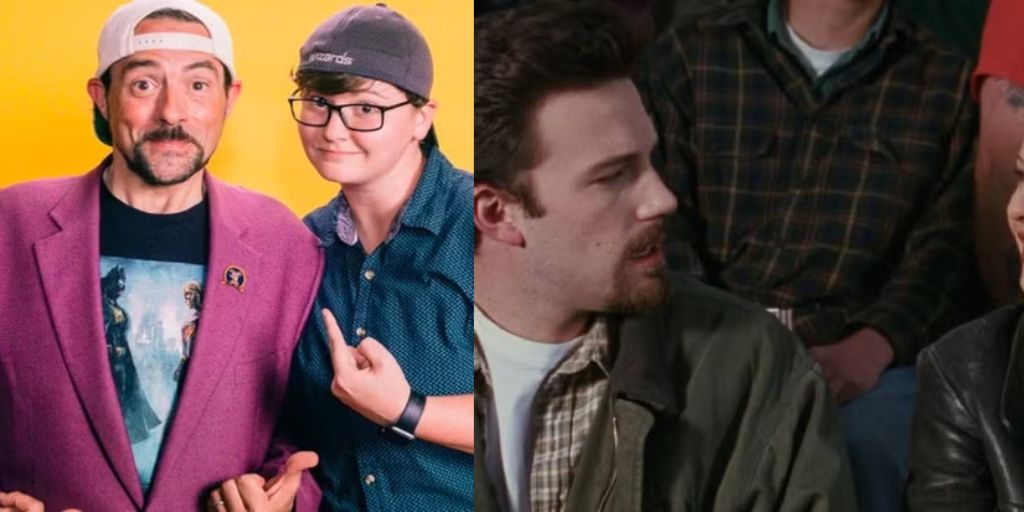The 1997 romantic comedy Chasing Amy brings up an interesting question: could this film be made today? If you ask different people, you will get a variety of answers. Directed by Kevin Smith, Chasing Amy follows the story of Holden (played by Ben Affleck), a comic book artist who is in love with Alyssa (played by Joey Lauren Adams). Holden is a lovesick character who falls head over heels for Alyssa, a confident and charming woman.
But there is a significant issue—Alyssa is an outspoken lesbian. While she desires a genuine friendship with Holden, she shows no romantic interest in men. This leads them both on a journey of self-exploration and sexuality, which surprises them along the way.
When considering whether Chasing Amy could be made in today’s context, I firmly believe the answer is “absolutely not.” However, that does not mean the film is without value. It stands out as Kevin Smith’s most emotional work. Although the film has some outdated terms and plot elements, it still feels ahead of its time in discussing fluid sexuality, especially in the context of the 1990s.
Despite the complex feelings many viewers have regarding the film, Chasing Amy was a significant success for Smith when it was released. It received positive reviews from critics, including a glowing recommendation from the famous Roger Ebert. The film made over $12 million at the box office, while it was produced on a budget of only $250,000.
This success established Chasing Amy as a notable work, even as it remains divisive, particularly among members of the queer community portrayed in the film. Some view it as a groundbreaking classic that depicts fluid sexuality in a way that many other films have not. Others criticize it as an outdated representation that reinforces harmful stereotypes about queer identities.
Even seasoned documentarians might shy away from tough questions in favor of a celebratory documentary about a beloved film. However, first-time filmmaker Sav Rodgers does not take that route in his engaging directorial debut, Chasing Chasing Amy.
This documentary provides an honest and multifaceted look at the legacy of a film that holds great significance for him. Rather than ignore the legitimate criticisms the film has received, Chasing Chasing Amy confronts these issues directly. At the same time, Sav eloquently shares how the 1997 film dramatically changed his life.
What is Chasing Chasing Amy About?
Sav Rodgers’ connection to Chasing Amy began with the Marvel superhero film Daredevil. This interest led him on a quest to watch all the movies starring Ben Affleck, which eventually brought him to Chasing Amy. The impact of the film was profound; Sav credits it with saving his life, especially considering his experiences as a closeted teenager who faced bullying.
This powerful story was shared in a TED Residency talk that went viral, attracting the attention of prominent figures like Marvel star Brie Larson, original Chasing Amy star Ben Affleck, and the film’s writer and director, Kevin Smith. After hearing Sav’s story, these individuals reached out to him, which marked the beginning of a significant journey.
In Chasing Chasing Amy, Sav’s deep relationships with the film’s subjects shine through. Kevin Smith is known for being a relatable and approachable filmmaker, a quality that comes across in his conversations with Sav. What could have easily turned into mere admiration instead feels like a meaningful exchange between two peers in the filmmaking world.
Another important figure in the documentary is Sav’s partner, Riley Rodgers, who has greatly influenced Sav’s life both personally and professionally. Their chemistry on screen is attracting and genuine, showcasing a bond that even the best romantic screenwriters would find hard to replicate.
At its heart, Chasing Chasing Amy provides a profound examination of the ups and downs in a filmmaker’s life and how discovering a significant movie influenced Sav’s development. While the title suggests a focus on the 1997 film, it is equally about Sav himself.
Although Sav is the filmmaker behind the camera, his authenticity shines through, making him feel like both the interviewer and the interviewee. This level of honesty is further amplified by the dramatic changes in Sav’s life while making the documentary, which remain central throughout the film’s 90-minute duration.
Multiple Perspectives on a Controversial Film
Chasing Chasing Amy begins with Sav asking, “Do you understand why I love this movie?” The first response he receives is a firm “No.” Many people, both in and out of the queer community, believe that Chasing Amy promotes ideas that can be seen as derogatory towards those who identify as LGBTQ+.
This perspective is understandable. Several interviewees in Chasing Chasing Amy point out a problematic scene from the original film, where Alyssa falls for Holden. In this scene, they share a romantic kiss in the rain, suggesting that a lesbian can be swayed into heterosexuality after an emotional monologue from a man.
Sav’s documentary does not shy away from these criticisms. Instead, it highlights them while also expressing Sav’s positive feelings about the original movie. While he praises Chasing Amy for showcasing characters with fluid sexualities, he does not claim it is perfect or universally loved.
He acknowledges that he was unaware of other significant films about queer identity that were released during the same time and could have served as better introductions to the LGBTQ+ community. Sav’s main point is not to label Chasing Amy as the ultimate example of LGBTQ+ storytelling; it is simply the first film that revealed to him that such stories existed.
This duality is illustrated in a memorable section of the documentary where both Kevin Smith and Joey Lauren Adams discuss their complicated feelings about Chasing Amy’s legacy. This moment represents a crucial turning point in the film.
However, it also briefly loses focus when comparing their memories of the controversial distributor Harvey Weinstein. While it is certainly valid to discuss Weinstein’s crimes, this topic feels somewhat disconnected from the documentary’s main themes of self-acceptance, representation, and the meaningful conversation about cinema.
Valuable Perspectives on Film Discussions
A striking quote in Chasing Chasing Amy comes from writer Princess Weekes, who says, “Something that’s problematic can still mean a lot in your development.” In an age where online film discussions often boil down to simple judgments like “it’s good” or “it’s bad,” Chasing Chasing Amy serves as an important reminder that conversations about film can be nuanced.
The documentary also emphasizes the significance of meaningful representation in cinema. This representation provides marginalized voices with an opportunity to be heard, even if it is not the primary goal of a film. The final scene of Chasing Chasing Amy feels like Sav is saying a bittersweet goodbye to this chapter of his life. Moving forward, Sav Rodgers is ready to embrace a promising filmmaking career.
As the documentary progresses, it becomes clear that Sav’s journey is about more than just a film. It is about personal growth, acceptance, and the influence that movies can have on our lives. The conversations he has with various figures, including Smith and Adams, add layers of understanding about the complexities of filmmaking and representation.
Analyzing the Legacy of Chasing Amy
Chasing Amy reflects its time, presenting a story that has been both celebrated and criticized. On one hand, it challenged norms and brought forward conversations about sexual identity and fluidity.
On the other hand, it also sparked debates regarding its portrayal of LGBTQ+ relationships and experiences. The impact of the film cannot be denied, as it opened doors for discussions that continue to this day.
Through Sav’s lens, we witness how Chasing Amy has shaped not just his life but also the lives of many others. The documentary highlights the importance of engaging with films critically while also recognizing the personal connections they can forge.
Sav’s reflections on his experiences as a closeted teenager resonate deeply. His narrative shows that films like Chasing Amy can provide solace and understanding to those struggling with their identities. While some may criticize the film for its flaws, it remains a pivotal work that speaks to the complexities of love and desire.
Understanding Cultural Impact
The cultural impact of Chasing Amy has evolved over the years. Initially, it was hailed for its progressive take on sexuality, yet as societal views have shifted, so too have the film’s interpretations. It serves as a historical marker for LGBTQ+ representation in cinema, illustrating how far the industry has come and how much further it has to go.
In today’s show, conversations about representation, inclusivity, and the portrayal of diverse identities are more prominent than ever. Filmmakers are challenged to create narratives that reflect the reality of their characters authentically. Sav’s documentary underscores the importance of continuing this dialogue and encourages filmmakers to consider the impact of their stories on viewers.
Personal Growth Through Film
Ultimately, Chasing Chasing Amy is about personal growth and self-discovery. It demonstrates how films can influence individuals and communities. Sav’s journey reveals the healing power of storytelling and the importance of having diverse narratives in cinema.
By engaging with the complexities of Chasing Amy, both positively and negatively, Sav encourages viewers to reflect on their relationships with films. He shows that while some movies may have problematic elements, they can still hold significance in one’s development.
Future of Filmmaking and Representation
Looking ahead, the future of filmmaking is bright with the promise of new voices and perspectives. As more filmmakers share their stories, the hope is for more authentic and inclusive representations of various identities. Sav’s work serves as a catalyst for these discussions, inspiring others to examine their experiences and the stories they want to tell.

The importance of platforms like Chasing Chasing Amy cannot be understated. They encourage critical conversations about representation, self-acceptance, and the ways films shape our understanding of ourselves and others. By fostering an environment where diverse narratives are celebrated, we can create a more inclusive cinematic show.
Conclusion: A Story of Connection and Change
Chasing Chasing Amy offers a rich scheme of the impact of Chasing Amy on individual lives and the broader cultural show. It serves as a reminder of the importance of storytelling in fostering understanding and connection among people.
Sav Rodgers’ journey demonstrates that while films may be flawed, their ability to inspire and challenge societal norms is invaluable. As the world of filmmaking continues to evolve, the legacy of Chasing Amy and its subsequent discussions will undoubtedly remain significant.




